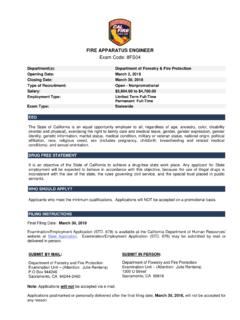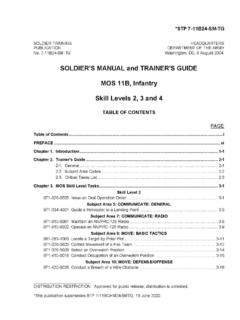Transcription of New Perspectives: Malaria Diagnosis - WHO
1 World Health OrganizationGenevaWHO/CDS/ OF A JOINT WHO/USAID INFORMAL CONSULTATION25 27 OCTOBER 1999 New PerspectivesMalaria Diagnosis1. EXECUTIVE SUMMARY42. INTRODUCTION 73. OBJECTIVES OF THE MEETING 94. APPROACHES TO THE Diagnosis OF Clinical Diagnosis Microscopic Rapid diagnostic tests (RDTs) Other techniques185. DIAGNOSTIC Areas of high Malaria Areas of low to moderate Malaria Special situations 276. ISSUES IN THE APPLICATION OF Technical characteristics Gold standard Packaging and ease of use Robustness of test Quality control and quality assurance New test Economic considerations Deployment Impact assessment367.
2 RESEARCH Research on the development of improved Operational field studies using existing diagnostics398. CONCLUSION429. REFERENCES43 Copyright World Health Organization 2000 This document is not a formal publication of the World Health Organization (WHO) and all rights are reserved by the document may, however, be reviewed, abstracted, quoted or translated in part, but not for sale or for use in conjunction with commercial authorization to reproduce or translate the work in full, and for any use by commercial entities,applications and enquires should be addressed to Roll Back Malaria , World Health Organization, Geneva, views expressed herein by named authors are solely the responsibility of those named by WHO by stages of the parasite.
3 Persistently positive tests (for some anti-gens) in spite of parasite clearance following chemotherapy; and rela-tively high cost per tests (microscopy and RDTs), used correctly, can contributeto better and more cost-effective disease management and can reducethe unnecessary and irrational use of antimalarial areas with high rates of transmission (mostly in Africa south of theSahara), where asymptomatic infections are frequent and health infra-structures are often inadequate, most Malaria treatment is based onclinical Diagnosis alone. In some situations, however, the clinical diag-nosis would benefit from laboratory confirmation by microscopy orRDTs. Such situations include suspected cases of severe Malaria ; sus-pected treatment failures; disease management by private-sector healthproviders in urban areas; and multidrug resistance (which is not yet aproblem in Africa south of the Sahara).
4 In areas with low to moderate rates of transmission (mostly in Asia andthe Americas, and in parts of Africa), most infections are symptomaticand multidrug resistance occurs in some areas (especially South EastAsia). These factors are strong incentives for laboratory confirmation ofmalaria as a component of disease management. While microscopy isgenerally available at the more central levels, it is often absent or unre-liable in remote areas. In such isolated localities, RDTs performed bylocal health workers or community volunteers can be used to diagnosemalaria, which can then be treated immediately, with the aim of reduc-ing morbidity and mortality and the incidence of severe multidrug resistance occurs, the cost of the recommended anti-malarial drugs is higher, thus justifying the use of RDTs whenmicroscopy is not other circumstances offer a potential role for RDTs in supportof microscopy.
5 These include complex health emergencies wheremalaria is a risk, suspected Malaria epidemics, and the Diagnosis ofmalaria in travellers and in military forces and organized , the microscope is a key tool in the integrated management ofdisease in resource poor settings, and the optimal role and conditionsIn Malaria patients, a prompt and accurate Diagnosis is the key to effec-tive disease management. The two diagnostic approaches currentlyused most often, however, do not allow a satisfactory Diagnosis ofmalaria. Clinical Diagnosis , the most widely used approach, is unreli-able because the symptoms of Malaria are very Diagnosis , the established method for laboratory confir-mation of Malaria , presents technical and personnel requirements thatoften cannot be met, particularly in facilities at the periphery of thehealth care system.
6 In addition, delays in the provision of themicroscopy results to the clinician mean that decisions on treatmentmay be taken without the benefit of the , the recent introduction of rapid diagnostic tests (RDTs) formalaria is of considerable interest. Such tests use immunochromato-graphic methods to detect Plasmodium-specific antigens in a finger-prick blood sample. The tests can be performed in approximately 15minutes by individuals with minimal training, using test kits (availablefrom several manufacturers) that require no electricity and no specialequipment. The RDTs have detection capabilities that are in generalcomparable to those generally achieved by microscopy in the healthservices.
7 Compared to microscopy, the main disadvantages of currentlyavailable RDTs are: lack of sensitivity at low levels of parasitaemia;inability to quantify parasite density; inability to differentiate betweenP. vivax, P. ovaleand P. malariae, as well as between the sexual and45 new perspectives : Malaria DIAGNOSIS1 ExecutiveSummaryEXECUTIVE SUMMARYP rompt and accurate Diagnosis is the key to effective disease manage-ment, one of the main interventions of the Global Malaria ControlStrategy (1). It is thus of concern that poor Diagnosis continues to hin-der effective Malaria control. This is due to a combination of factors,including non-specific clinical presentation of the disease, high preva-lence of asymptomatic infection in some areas, lack of resources andinsufficient access to trained health care providers and health facilities,and widespread practice of self-treatment for clinically major contributing factor, however, is that the laboratory diagno-sis of Malaria has up to now relied nearly exclusively on microscopy, avaluable technique when performed correctly but unreliable andwasteful when poorly executed.
8 A better utilization of microscopy andthe development of alternative diagnostic techniques could substan-tially improve Malaria control (2). Such objectives prove particularlyrelevant to the Roll Back Malaria initiative, a global movement thatemphasizes better application of existing tools and the development ofnew ones. Of great interest in this context is the development during the past tenyears of rapid diagnostic tests (RDTs) for Malaria using immunochro-matographic test strips, which might offer a valid alternative to orcomplement microscopy (3). Various RDTs have been tested in clinicalfor the use of RDTs in relation to microscopy remain to be issues need to be addressed through laboratory or fieldresearch, situation analysis, modelling and institutional issues include: further improvement of the technical character-istics of RDTs ( sensitivity, specificity, ease of performance by usersand robustness); a system of international quality control and qualityassurance outside the commercial sector, including the development ofa bank of reference reagents and a network of field test sites.
9 And amultidisciplinary analysis of the cost of deploying RDTs in various sit-uations, as well as their potential for reducing Malaria morbidity andmortality and delaying the emergence of drug resistance. 67 new perspectives : Malaria DIAGNOSISINTRODUCTION2 IntroductionThe objectives of the informal consultation were: to define the rational use of microscopy and of RDTs for malariacontrol; to identify factors that determine the choice of approaches to thediagnosis of Malaria ; to define the desired specifications for new diagnostic tests; and to outline outstanding research questions and plan a research field situations. Test kits have been marketed and have found lim-ited use in some Malaria control programmes, as well as in special sit-uations such as complex emergencies, epidemics and the Diagnosis ofmalaria in returning travellers.
10 The overall results have been encourag-ing, and several manufacturers are currently developing improved kitsand offering them on the global market. The strong market presence ofsuch kits is illustrated by the fact that one manufacturer alone reportshaving introduced 3 6 million tests to date. The time has thus come for serious consideration of how RDTs canmost effectively be applied to the very diverse situations in whichmalaria occurs. To that effect, an informal consultation was convenedin Geneva on 25 27 October 1999, bringing together the developers,manufacturers and potential users of RDTs, and representatives ofother interested agencies, to discuss future actions to ensure their opti-mal deployment to control PERSPECTIVES: Malaria DIAGNOSISOBJECTIVES OF THE MEETING3 Objectives ofthe meetingnon-specific and overlap with those of other febrile illnesses.















